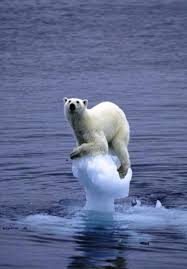Glaciers are melting faster today as compared to the past many centuries. Why this sudden change? Almost everyone believe that the prime reason for this is sudden and rapid industrialization which in turn has caused global warming - the prime culprit of fast melting glaciers.
Global warming is the rise in average global temperature that has happened over the past century. The 'industrial revolution' is the main cause of this rise in average temperature. The indiscriminate burning of fossil fuels has resulted in extreme atmospheric pollution leading to this condition. Coal is still burnt in huge quantities for various reasons such as electricity production. Burning of oil is a major culprit in the past century. Deforestation has increased to procure wood and make more space available for farming, resulting in an increase in carbon dioxide concentrations. All these pollutants help in trapping more heat in the earth's atmosphere, increasing global temperatures.
In the future the global temperature will in all likelihood keep increasing, melting glaciers even faster than they are today.
Faster than normal melting glaciers will cause the streams and rivers to overflow causing flooding. This is a reality that many places have and are currently facing. Those living in close proximity to these rivers will need to relocate. Farmlands get destroyed in these flood waters. Higher up on mountains this excess water creates new ponds. As these ponds keep getting filled with more water they form lakes with the pressure on the boundaries increasing. There is always a threat of these lakes bursting, causing huge floods in villages situated below.
Once the glacier has totally melted, the streams and rivers will run dry. Farmland will turn dry. Those depending on freshwater from the melting glacier will have to relocate.
Places that depend on the constant flow of this water for the production of electricity will have to look for other sources to produce electricity. This will cause further atmospheric pollution and cost much more to produce.
Places that depend on the constant flow of this water for the production of electricity will have to look for other sources to produce electricity. This will cause further atmospheric pollution and cost much more to produce.
Sea levels that have already risen due to warmer waters will rise even further when all this water from melting glaciers empty into the sea. At immediate risk will be to those living in low-lying areas in close vicinity to seashores. These areas will get flooded and sweet groundwater will get polluted with sea water making it unfit for human use. All these people will have to relocate.
Many animals, birds, and fish that depend on the fresh water from glaciers that empty directly into the sea will become endangered. Corals will suffer because of low sunlight due to increasing sea-levels. Fish feeding on these corals will in turn get affected. Animals and birds feeding on these fish will be affected.
There are many more dangers that could crop up due to fast melting glaciers in the coming years if we do not do something to reduce the menace of global warming immediately. Each one of us can play a part in helping reduce harmful emissions, leading to a possible reduction in future global warming.











































